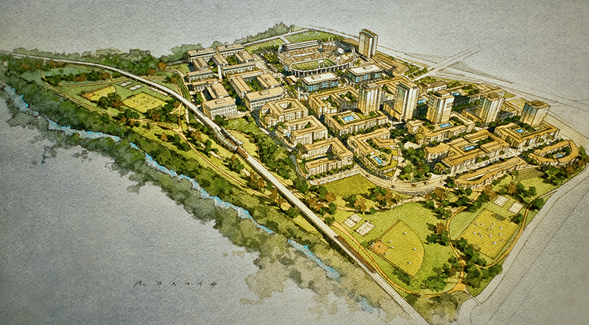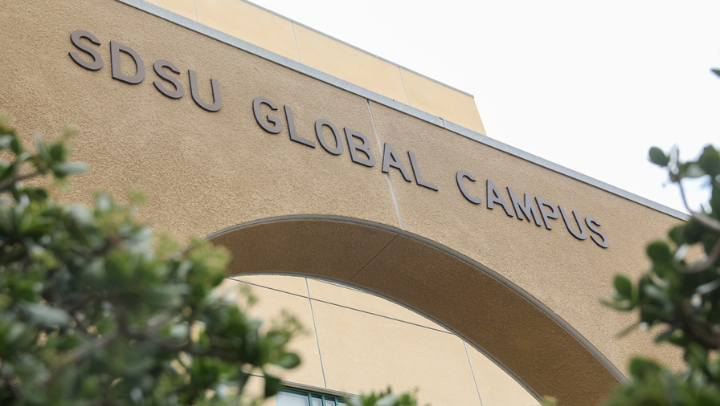SDSU Stories to Watch in 2018
Take a look at SDSU's top news stories to watch in 2018.

SDSU eyes Mission Valley campus
SDSU is wrapping up a year-long 120th anniversary celebration that marked major milestones in its storied history—from early days as a small teachers’ college to current status as a national research university of 36,000 students enrolled in bachelor’s, master’s and doctoral programs.In 2018, the focus will be turning to future goals as the university eyes an exciting expansion plan for 166 acres of land in Mission Valley, including and immediately surrounding the SDCCU Stadium (home to Aztec football), and just three trolley stops west of the main campus.
Landlocked within its 237-acre campus on Montezuma Mesa, SDSU for years has looked to identify opportunities for expansion to better serve increasing demands for higher education and continue supporting the regional economy.
The proposed public-private partnership project in Mission Valley, which was announced in November, encompasses classroom and research buildings, a river park and green open spaces, student and work-force housing and neighborhood-serving retail shops. It also calls for a pair of hotels and conference center, as well as a multi-purpose 35,000-seat stadium for college football, professional soccer and other sports. The plan does not rely on taxpayer dollars.
At the intersection of science and engineering
In January, SDSU’s newest building, the Engineering and Interdisciplinary Sciences (EIS) Complex, will open its doors to students, faculty and staff. The 85,000-square-foot building sits just north of the Engineering Building and is constructed in the California Mission Revival style. The EIS Complex is designed around collaboration, with shared lab and meeting spaces that encourage scientists and engineers from diverse disciplines to see where their work overlaps.The goal is that by finding common ground, researchers will be able to tackle some of society’s greatest challenges, including climate change and water quality. Keep an eye out for new findings from the Viral Information Institute, which moves into the EIS Complex next semester. SDSU computer scientist Rob Edwards, for example, is in the process of pioneering a whole new approach to viral discovery that could lead to breakthroughs in personalized medicine.
MRI – a first for the university
The basement of the EIS Complex will house SDSU’s new magnetic resonance imaging (MRI) machine—a first for the university. The powerful brain imaging tool, managed by psychologist Martin Sereno, will allow students and researchers to answer complicated questions about the underpinnings of the brain and make progress in dealing with autism, fetal alcohol syndrome, language acquisition, traumatic brain injury and many other brainy topics.Searching for the next president
The top job on campus is open and the big question is: who will fill it?The search is underway by the California State University Board of Trustees for the next SDSU president who will need to tackle several major challenges as he or she assumes office in early summer 2018.
Since the June departure of Elliot Hirshman after six years at the helm, the university has been led by Sally Roush—the first woman to serve in the top position and formerly SDSU’s senior vice president for Business and Financial Affairs.
SDSU has had only 10 presidents since 1898. The campus community and region at large eagerly await the announcement of No. 11, who will be building on the university’s legacy as a major public research university rooted in academic and athletic excellence.
Drone Lab takes flight
As drones become more popular and affordable, SDSU’s new Center for Unmanned Systems Technologies, or Drone Lab for short, is looking to become not just the university’s hub for “drone policy, safety protocols, research, fun and general avionics,” but also a major regional asset. The Drone Lab opened this past year, but is looking to greatly expand its offerings to the campus community and beyond in 2018, partnering with SDSU researchers and students as well as industry members in the greater San Diego region.More than 93,000 apply to SDSU
SDSU continues to be one of the most sought-after colleges in the nation with a record-setting 93,610 undergraduate applications for fall 2018. This is the third year in a row that the university received more than 80,000 undergraduate applications and the first time it has topped 90,000.These prospective students represent the most economically, ethnically and geographically diverse pool of talent ever to apply to SDSU. Acceptance notifications will go out in March.
Healthy rivers, healthy communities
Trent Biggs and Natalie Mladenov are just two of the SDSU researchers looking at ways to improve water quality throughout San Diego’s waterways. The research team is investigating the heavily polluted stretch of the San Diego River running through Mission Valley. Their novel approaches include restoring natural vegetation in the river’s tributaries out in the highlands of East County to improve water quality upstream, as well as experimenting with ways to reduce oxygen-depleted zones further downstream that breed bacteria.Twenge on teens
SDSU psychology professor Jean Twenge’s recent findings on the rise of anxiety and depression, specifically in young girls, has garnered the attention of both local and national media outlets as well as major online publications.Twenge’s continued research is on the mental health of the iGen, which she describes as the first generation to spend their entire adolescence in the age of the smartphone. It plays into a much larger national conversation on the effects of technology on today’s youth. Twenge has several major research papers due out in 2018.
Budding entrepreneurs
Thanks to solid entrepreneurship programs like the Zahn Innovation Platform and the Lavin Entrepreneurship Center, SDSU is a hotbed for innovation and collaboration. Here are several entrepreneurs and their projects worth watching in 2018:Breanne Acio is developing Gather, an app that helps van-residing folks connect and find resources while on the road.
Shan Cureton-James is creating Kidde Commute, a full-service transportation company for children in the greater San Diego area.
Micheal Green is starting up Rosey Corp, a system that allows teachers and professors to grade their students' work using artificial intelligence, making grading more efficient.
Alim Kahn is onboarding Alimination, an all-in-one skateboard tool that allows you to fix your skateboard on the go. The nifty gadget fits comfortably in your pocket.
Xander Schauffele hits the greens
2017 was a great year for former SDSU golf standout Xander Schauffele. Not only was he named the PGA Tour Rookie of the Year, he has also risen to No. 25 in the world rankings following victories at the PGA Tour Championship, The Greenbrier Classic and a tied fifth-place finish at the U.S. Open.A two-time PING All-West Region honoree, Schauffele received All-America recognition following a stellar senior campaign at SDSU in 2015, garnering third-team accolades from the both the Golf Coaches Association of America and Golfweek. We predict big things for Schauffele in 2018.
Wellness across borders
San Diego’s position on the U.S.-Mexico border provides SDSU students and faculty with an up-close look at border issues that affect people in both countries. Keep an eye on SDSU Imperial Valley undergraduate student Marisabel Coronado’s ongoing research into the societal and cultural factors that influence people’s cancer care decisions on both sides of the border. Coronado won the Dean’s Award for presentation of her work at the 2017 SDSU Student Research Symposium in March.Delivering produce to food deserts
SDSU associate professor Iana Castro recently launched BrightSide Produce San Diego, a program aimed at making affordable fruits and vegetables more readily available in underserved communities with limited access to fresh, healthy food. BrightSide Produce is managed and operated as part of the marketing department curriculum in SDSU’s Fowler College of Business. It provides students with the opportunity to operate a business while they are still in school.Jenavee Peres batting for the fences
SDSU senior catcher Jenavee Peres joined elite company during her junior season on Montezuma Mesa, becoming just the fourth Aztec to be named a National Fastpitch Coaches Association All-American. The Mountain West Player of the Year and first-team All-MW selection batted .454 on the season with 56 runs, 74 hits, 16 home runs and 60 RBIs, while posting a .840 slugging percentage and a .492 on-base percentage. Peres shattered the previous school record of a .429 batting average and tied an SDSU record with five sac flies. Heading into her final season in 2018, Peres owns school records in batting average (.409), on-base percentage (.466), slugging percentage (.743) and OPS percentage (1.209), and looks to end her illustrious Aztec career on a high note.Arts are Alive at SDSU
SDSU-hosted performing and visual arts are alive and well on campus and throughout the greater San Diego community.Next year will bring even more programming on-site and at venues throughout the county, including an encore performance downtown with the San Diego Symphony. In April, more than 200 SDSU performers will collaborate with professional musicians in what’s billed as the largest off-campus, non-athletic event.
Keep your ears tuned for news of a collaborate position with the San Diego Opera and your eyes alert for a fall appearance by American artist Nick Cave, director of the graduate fashion program at the Art Institute of Chicago who is best known for his bright-colored and whimsical fabric sculpture Soundsuits.



